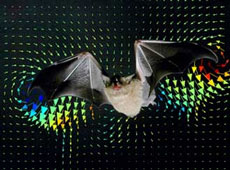How do other flying bats look like?
While birds have the most popular flying technique in vertebrates, bats can still fly easily without feathers. Swedish researcher Anders Hedenstrom and his colleagues at Lund University decided to test the way of flying bats thanks to an elastic membrane on the wings.
 (Photo: HTV) When the wings are raised above the bird, the bird can separate feathers at the edge of the wings to allow air to pass through and reduce drag. With a stretchable elastic film, bats don't have this utility.
(Photo: HTV) When the wings are raised above the bird, the bird can separate feathers at the edge of the wings to allow air to pass through and reduce drag. With a stretchable elastic film, bats don't have this utility.
The researchers placed bats Glossophaga Soricina in front of a bellows. At low speeds, bats gently bend their wings and take advantage of air movement to increase thrust. The researchers noted that, when flying at a faster pace, they slightly folded their wings to reduce drag.
When added to the dust blower, Dr. Hedenstrom and colleagues recreated the wind movement created by bats while flying. Each wing creates a swirling wind motion and maintains this movement during flight, while in birds, two vortex movements have re-merged into a bird tail.
The bats' slow and fast flight speed has caught the attention of remote-controlled small-scale remote control technicians in urban areas. This is not the first time aeronautical engineers are interested in bats. In the 1880s, the first Éole aircraft of French engineer Clément Ader was equipped with bat-like wings with elastic membranes.
Power
- Find the world's fastest flying animal
- Bats are silent when flying in groups
- Bats are thirsty because of the hot sun piling up in Australia
- Bats do not land similarly
- How do bats spread disease globally?
- Bats threaten a city in Australia
- why are bats afraid of water?
- Mysterious animals cross between monkeys and bats
- Discover new bats on dogs in Panama and Ecuador
- Terrible hot sun causes bats to fall like a fig in Australia
- Discover panda bat in South Sudan
- Discover 4 strange bat species
 Animal 'suffering' after hibernation
Animal 'suffering' after hibernation Why do goats climb well?
Why do goats climb well? Scientists were surprised to see chimpanzees eating turtles
Scientists were surprised to see chimpanzees eating turtles Giant catfish died deadly due to drought in Thailand
Giant catfish died deadly due to drought in Thailand